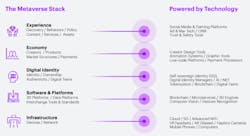The Metaverse: High Tech’s New Gold Rush
What you'll learn:
- High tech's increasing turn toward the metaverse.
- New growth opportunities involving the metaverse.
With the metaverse on track to become the next big wave of technology innovation, we’re seeing companies of all types and sizes on board the “the metaverse or bust” train. It’s clear the “gold” is there, triggering companies to rush to find out how they can best play and take advantage of the massive opportunities in front of them. And amidst this flurry of activity and mining is one group that stands to benefit the most—the high-tech industry.
Just think about it. High-tech companies have an advantage like no other industry today: They make the hardware that powers the metaverse’s underlying technology. This position can translate into significant business opportunities, and executives are starting to notice. Recent Accenture research shows that 44% of semiconductor executives expect to allocate more than 20% of their semiconductor production budget to the metaverse by 2024 (Fig. 1).
However, these opportunities expand much further than providing the hardware. To fully capitalize on the metaverse, high-tech companies need to look beyond their core business and figure out where else they can play in the metaverse value chain. This includes platform building and experience creation for augmented-reality (AR), virtual-reality (VR) and mixed-reality environments.
Billion Dollar Opportunity
At the Consumer Electronics Show (CES), we saw many use cases with businesses and consumers adopting the technology. Lenovo introduced a device called Project Chronos that allows users to animate an avatar in the metaverse without the need for a headset or other wearable sensors. Likewise, Samsung updated its Freestyle portable projector with a new set of capabilities claimed to be geared toward new use cases such as real-world metaverse applications.
As these examples demonstrate, the metaverse has the potential to transform how businesses interact with customers, how work is done, what products and services companies offer, how they make and distribute them, and how they operate their organizations. As a result, billions of dollars in untapped market potential are up for grabs in building the platforms and designing the experiences that support the metaverse.
If high-tech companies take on new roles in the value chain, they open themselves to new growth opportunities. These include:
- Applying metaverse technologies to your business: High-tech and semiconductor businesses are starting to use digital twins to model and simulate production processes with an immersive three-dimensional layout of the factory floor, including equipment and product handling tools. This enables them to accelerate sales cycles, preemptively identify issues, or improve field services efficiency.
- Identifying opportunities close to your core business: Offering “metaverse-ready” devices, networks, or services is a great way to update existing products for the nascent market. Meanwhile, expanding into platforms and user experiences helps high-tech businesses find new entry points into the metaverse.
- Understanding the impact these investments have on your brand and core business: For example, moving into the metaverse platform space may drive up the sales of other core products unrelated to the metaverse.
High-tech players are picking and choosing where and when to play in the metaverse value chain (Fig. 2). In many cases, this means extending beyond their legacy business to enable the value potential demanded by their customers. A perfect example is NVIDIA, which has developed tools to provide the capabilities needed by metaverse developers to bring their visions to life. For instance, its Omniverse Avatar Cloud Engine (ACE) is a suite of cloud-native AI microservices that makes it easier to build and deploy intelligent virtual assistants and digital humans at scale.
The Metaverse or Bust!
As high tech explores new roles in the value chain, they need to look for ways to invest in new capabilities, or use existing ones in different ways, to expand beyond their core hardware business to potentially more lucrative segments of the metaverse.
While we’re in the early days of the metaverse, leaders who shy away from the uncertainties and challenges that any new technology innovation goes through will soon be operating in worlds defined by others. The time to act is now, and high-tech companies are in the front-row seat to build and shape the world of tomorrow.
About the Author
Syed Alam
Global High Tech Industry Lead, Accenture
Syed Alam is the Global High Tech Industry Lead at Accenture, which includes semiconductor, enterprise tech, network equipment, consumer tech, and med-tech clients. In his role, Syed works at the intersection of business strategy and high-tech industry, helping companies transform by developing and executing growth strategy, creating new revenue streams in adjacent markets organically and through M&A, leveraging new revenue models, and optimizing the supply-chain operations to equip for growth.


